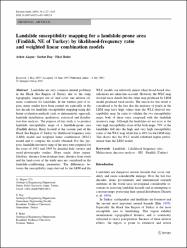| dc.contributor.author | Akgun, Aykut | |
| dc.contributor.author | Dag, Serhat | |
| dc.contributor.author | Bulut, Fikri | |
| dc.date.accessioned | 2014-09-15T06:23:28Z | |
| dc.date.available | 2014-09-15T06:23:28Z | |
| dc.date.issued | 2008 | |
| dc.identifier.citation | 67 | en_US |
| dc.identifier.issn | 0943-0105 | |
| dc.identifier.uri | https://doi.org/10.1007/s00254-007-0882-8 | |
| dc.description.abstract | Landslides are very common natural problems in the Black Sea Region of Turkey due to the steep topography, improper use of land cover and adverse climatic conditions for landslides. In the western part of region, many studies have been carried out especially in the last decade for landslide susceptibility mapping using different evaluation methods such as deterministic approach, landslide distribution, qualitative, statistical and distribution-free analyses. The purpose of this study is to produce landslide susceptibility maps of a landslide-prone area (Findikli district, Rize) located at the eastern part of the Black Sea Region of Turkey by likelihood frequency ratio (LRM) model and weighted linear combination (WLC) model and to compare the results obtained. For this purpose, landslide inventory map of the area were prepared for the years of 1983 and 1995 by detailed field surveys and aerial-photography studies. Slope angle, slope aspect, lithology, distance from drainage lines, distance from roads and the land-cover of the study area are considered as the landslide-conditioning parameters. The differences between the susceptibility maps derived by the LRM and the WLC models are relatively minor when broad-based classifications are taken into account. However, the WLC map showed more details but the other map produced by LRM model produced weak results. The reason for this result is considered to be the fact that the majority of pixels in the LRM map have high values than the WLC-derived susceptibility map. In order to validate the two susceptibility maps, both of them were compared with the landslide inventory map. Although the landslides do not exist in the very high susceptibility class of the both maps, 79% of the landslides fall into the high and very high susceptibility zones of the WLC map while this is 49% for the LRM map. This shows that the WLC model exhibited higher performance than the LRM model. | en_US |
| dc.language.iso | eng | en_US |
| dc.publisher | Springer | en_US |
| dc.relation.ispartof | Environmental Geology | en_US |
| dc.rights | info:eu-repo/semantics/closedAccess | en_US |
| dc.subject | Landslide Likelihood frequency ratio Multicriteria decision analysis GIS Findikli (Turkey) | en_US |
| dc.title | Landslide susceptibility mapping for a landslide-prone area (Findikli, NE of Turkey) by likelihood-frequency ratio and weighted linear combination models | en_US |
| dc.type | article | en_US |
| dc.relation.publicationcategory | Makale - Uluslararası Hakemli Dergi - Kurum Öğretim Elemanı | en_US |
| dc.description.wospublicationid | WOS:000255745700001 | en_US |
| dc.department | Gümüşhane Üniversitesi | en_US |
| dc.authorid | Akgun, Aykut / 0000-0001-5212-6447 | |
| dc.authorid | Akgun, Aykut / 0000-0002-2843-1633 | |
| dc.identifier.volume | 54 | en_US |
| dc.identifier.issue | 6 | en_US |
| dc.identifier.startpage | 1127 | en_US |
| dc.identifier.doi | 10.1007/s00254-007-0882-8 | |
| dc.identifier.endpage | 1143 | en_US |
| dc.authorwosid | Akgun, Aykut / B-3880-2008 | |


















